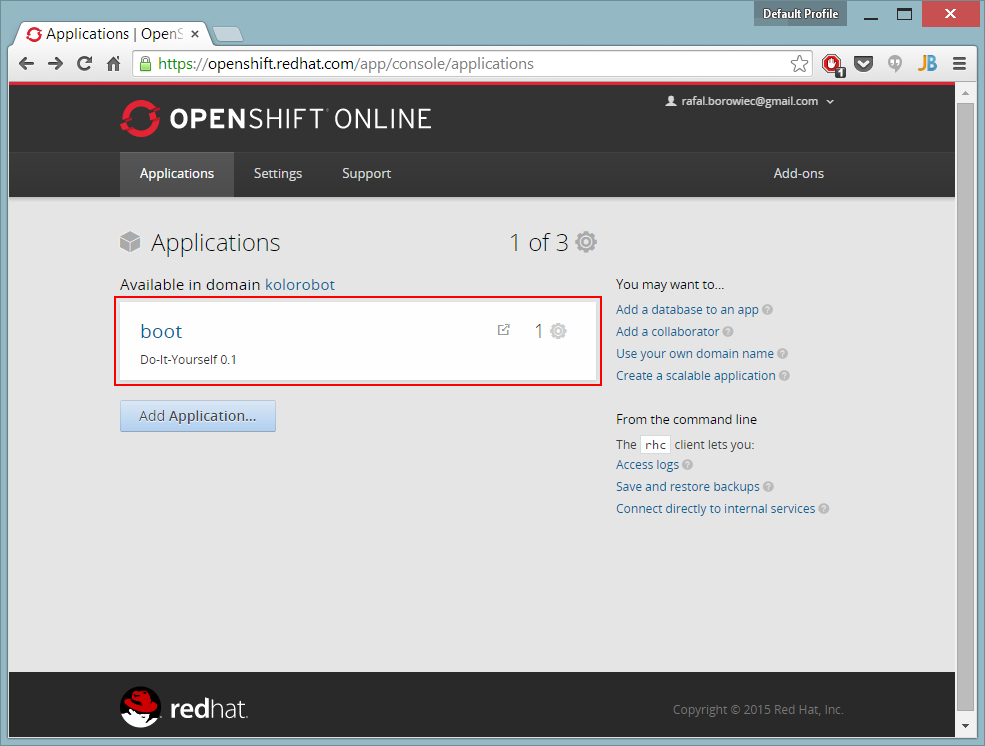OpenShift DIY: Build Spring Boot / Undertow application with Gradle
 Gradle 1.6 was the last supported Gradle version to run on OpenShift due to this bug. But as of Gradle 2.2 this is no more an issue, so running newest Gradle on OpenShift should not be a problem anymore with Do It Yourself cartridge. DIY cartridge is an experimental cartridge that provides a way to test unsupported languages on OpenShift. It provides a minimal, free-form scaffolding which leaves all details of the cartridge to the application developer.
Gradle 1.6 was the last supported Gradle version to run on OpenShift due to this bug. But as of Gradle 2.2 this is no more an issue, so running newest Gradle on OpenShift should not be a problem anymore with Do It Yourself cartridge. DIY cartridge is an experimental cartridge that provides a way to test unsupported languages on OpenShift. It provides a minimal, free-form scaffolding which leaves all details of the cartridge to the application developer.
This blog post illustrates the use of Spring Boot 1.2 and Java 8 running on Undertow, that is supported as a lightweight alternative to Tomcat. It should not take more than 10 minutes to get up and running.
Prerequisite
Before we can start building the application, we need to have an OpenShift free account and client tools installed.
Step 1: Create DIY application
To create an application using client tools, type the following command:
rhc app create <app-name> diy-0.1
This command creates an application using DIY cartridge and clones the repository to directory.
Step 2: Delete Template Application Source code
OpenShift creates a template project that can be freely removed:
git rm -rf .openshift README.md diy misc
Commit the changes:
git commit -am "Removed template application source code"
Step 3: Pull Source code from GitHub
git remote add upstream https://github.com/kolorobot/openshift-diy-spring-boot-gradle.git git pull -s recursive -X theirs upstream master
Step 4: Push changes
The basic template is ready to be pushed to OpenShift:
git push
The initial deployment (build and application startup) will take some time (up to several minutes). Subsequent deployments are a bit faster:
remote: BUILD SUCCESSFUL remote: Starting DIY cartridge remote: XNIO NIO Implementation Version 3.3.0.Final remote: b.c.e.u.UndertowEmbeddedServletContainer : Undertow started on port(s) 8080 (http) remote: Started DemoApplication in 15.156 seconds (JVM running for 17.209)
You can now browse to: http://<app-name>.rhcloud.com/manage/health and you should see:
{
"status": "UP",
}When you login to your OpenShift web account and navigate to Applications you should see the new one:
Under the hood
Why DIY?
Spring Boot application can be deployed to Tomcat cartridge on OpenShift. But at this moment no Undertow and Java 8 support exists, therefore DIY was selected. DIY has limitations: it cannot be scaled for example. But it is perfect for trying and playing with new things.
Application structure
The application is a regular Spring Boot application, that one can bootstrapped with http://start.spring.io. Build system used is Gradle, packaging type is Jar.
As of Spring Boot 1.2 Undertow lightweight and performant Servlet 3.1 container is supported. In order to use Undertow instead of Tomcat, Tomcat dependencies must be exchanged with Undertow ones:
buildscript {
configurations {
compile.exclude module: "spring-boot-starter-tomcat"
}
}
dependencies {
compile("org.springframework.boot:spring-boot-starter-undertow")
}OpenShift specificic configuration – application-openshift.properties – contains the logging configuration at the moment:
logging.file=${OPENSHIFT_DATA_DIR}/logs/app.logOpenShift action_hooks
OpenShift executes action hooks script files at specific points during the deployment process. All hooks are placed in the .openshift/action_hooks directory in the application repository. Files must have be executable. In Windows, in Git Bash, the following command can be used:
git update-index --chmod=+x .openshift/action_hooks/*
Deploying the application
The deploy script downloads Java 8 and Gradle 2.2, creates some directories. Downloading Gradle is done the following way:
if [ ! -d $OPENSHIFT_DATA_DIR/gradle-2.2.1 ]
then
cd $OPENSHIFT_DATA_DIR
wget https://services.gradle.org/distributions/gradle-2.2.1-bin.zip
unzip gradle-2.2.1-bin.zip
rm -f gradle-2.2.1-bin.zip
fiAfter running the script the following directories will be created in $OPENSHIFT_DATA_DIR:
gradle gradle-2.2.1 jdk1.8.0_20 logs
In addition, the script exports couple of environment variables required to properly run Java 8 / Gradle build. GRADLE_USER_HOME is most important one as it sets the home directory where all the Gradle runtime files will be stored, including downloaded dependencies used to build the application.
The final command of the deploy script is to run Gradle task to create an jar archive that can be executed from the command line using java -jar commnad (see next paragraph):
gradle bootRepackage
Starting the application
When deploy script finishes successfully, the build directory will contain a single jar with the Spring Boot application assembled. The application is started and bound to the server address and port provided by OpenShift. In addition, the profile name is provided, so additional properties file can be loaded. The final command that runs the application is as follows:
nohup java -Xms384m -Xmx412m -jar build/*.jar --server.port=${OPENSHIFT_DIY_PORT} --server.address=${OPENSHIFT_DIY_IP} --spring.profiles.active=openshift &References
- The project source code, used throughout this article, can be found
on GitHub: https://github.com/kolorobot/openshift-diy-spring-boot-sample - Spring Boot documentation: http://docs.spring.io/spring-boot/docs/current/reference/htmlsingle/#cloud-deployment-openshift
- Some OpenShift references used while creating this article:
| Reference: | OpenShift DIY: Build Spring Boot / Undertow application with Gradle from our JCG partner Rafal Borowiec at the Codeleak.pl blog. |






